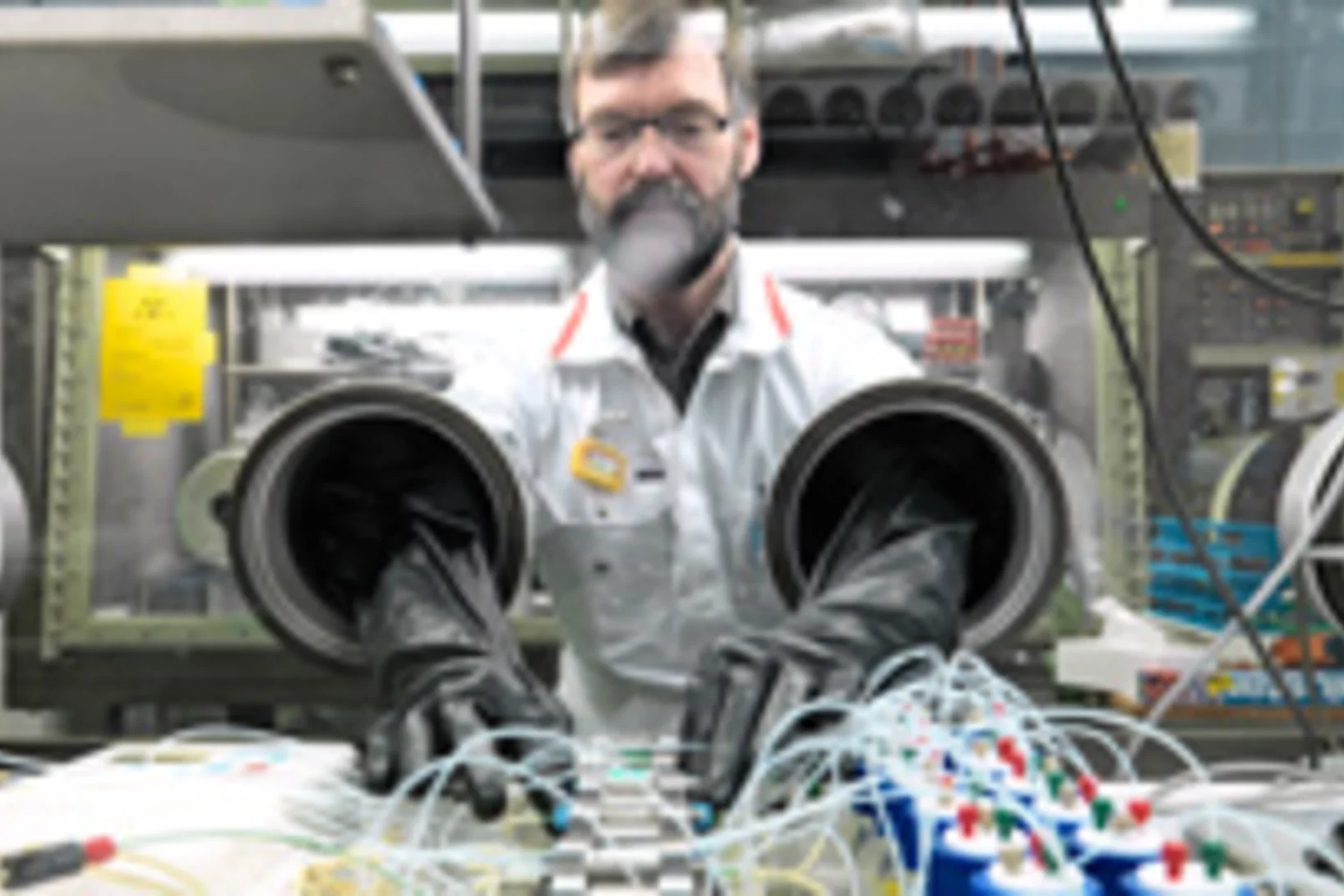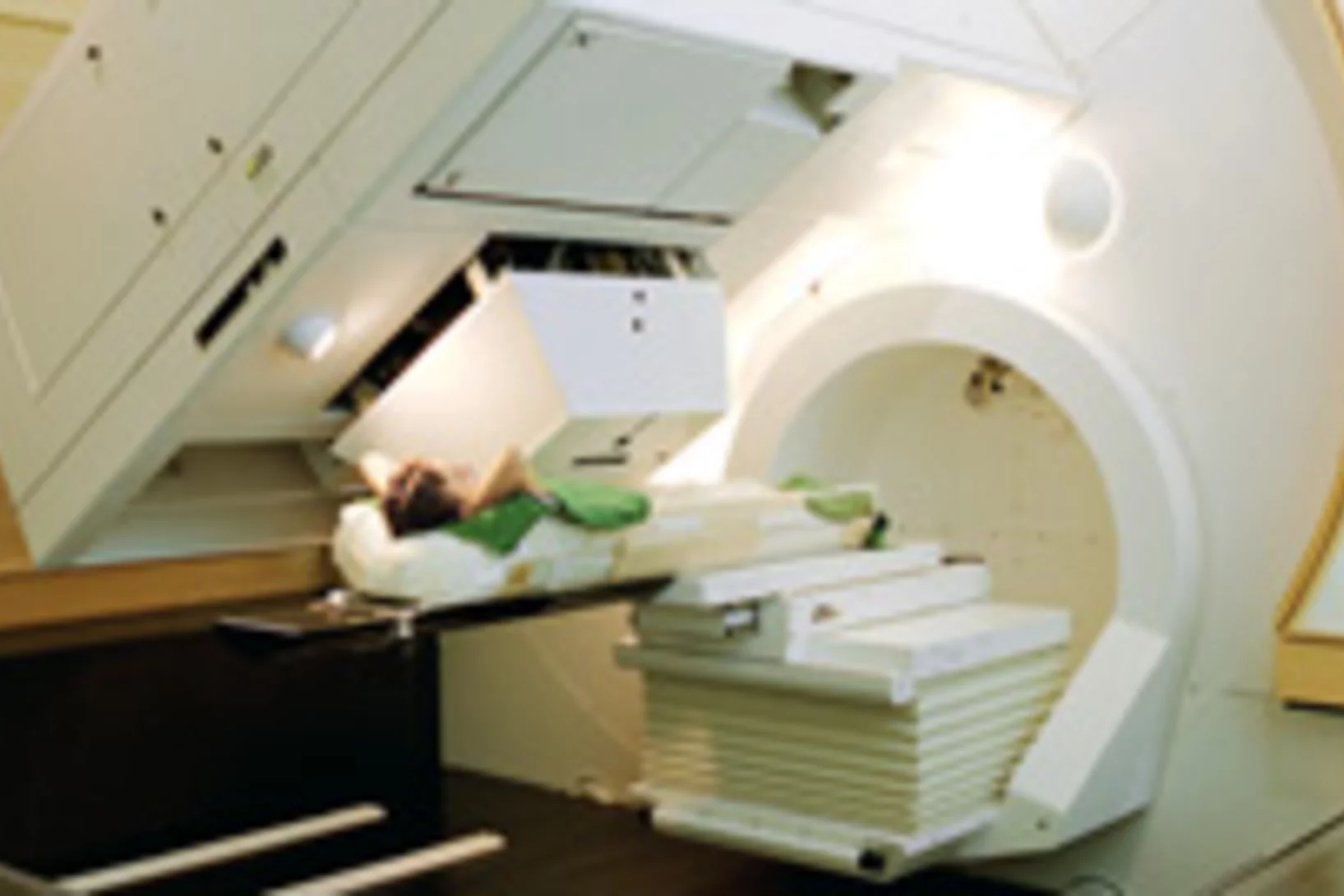Am Paul Scherrer Institut suchen Forschende nach Antworten auf die fundamentale Frage nach den Grundstrukturen der Materie und den fundamentalen Funktionsprinzipien in der Natur. Sie untersuchen Aufbau und Eigenschaften der Elementarteilchen – der kleinsten Bausteine der Materie – oder gehen der Frage nach, wie biologische Moleküle aufgebaut sind und wie sie ihre Funktion erfüllen. Das so gewonnene Wissen öffnet neue Lösungsansätze in Wissenschaft, Medizin oder Technologie.
Mehr dazu unter Überblick Grundlagen der Natur
Chemie-Nobelpreisträger 2009 forscht am Paul Scherrer Institut
Das Paul Scherrer Institut gratuliert Professor Venkatraman Ramakrishnan zum Erhalt des diesjährigen Nobelpreises für Chemie. Ramakrishnan ist langjähriger Nutzer der Synchrotron Lichtquelle Schweiz SLS des Paul Scherrer Instituts und führt hier regelmässig Experimente zur Bestimmung der Struktur von Ribosomen durch, für die er nun den Nobelpreis erhalten hat.
Sichere Endlagerung - Untersuchung spezifisch schweizerischer Gegebenheiten
Radioaktive Abfälle aus Kernkraftwerken sowie aus Medizin, Industrie und Forschung müssen über sehr lange Zeit von der Umwelt und insbesondere dem Lebensraum der Menschen ferngehalten werden. Fachleute am PSI befassen sich seit Jahren mit wissenschaftlichen Fragen zum Sicherheitsnachweis für geologische Endlager. Die PSI-Forschung widmet sich vor allem den physikalisch-chemischen Vorgängen in Endlagersystemen. Sie will zu einer realistischen Beschreibung der mit der Lagerung radioaktiver Abfälle verbundenen Risiken gelangen.
Strukturen und Auswirkungen nationaler und internationaler Energiesysteme – nationale Klimaziele für die Schweiz
Das Paul Scherrer Institut analysiert Strukturen und Auswirkungen nationaler und internationaler Energiesysteme.So wurde zum Beispiel im Jahr 2007 eine Studie erstellt, in der das PSI Empfehlungen gibt, welches die nationalen Klimaziele der Schweiz sein könnten.
Gefrorenes Klimagedächtnis
In Gletschereis können Informationen über das Klima und die Zusammensetzung der Atmosphäre in vergangenen Jahrhunderten gespeichert sein. PSI-Forschende unternehmen regelmässig Forschungsreisen in verschiedene Gebiete um dort Eisbohrkerne zu entnehmen. Ein solcher Eisbohrkern ist gewissermassen eine Eissäule, die aus dem Gletscher herausgebohrt wurde. Im Labor wird der Bohrkern Schicht für Schicht aufgetaut und auf seine Zusammensetzung untersucht. So liefert er zahlreiche Einblicke in verschiedene Aspekte der Klimavergangenheit.
Ticket für die Reise durch die Zelle
Publikation in Cell. Forscher entdecken Mechanismus für wesentliche Erkennungsvorgänge in lebenden Zellen. Über ihre Ergebnisse berichten die Forscher in der neuesten Ausgabe der Fachzeitschrift Cell.
Treibstoff aus Sonnenenergie
Auszeichnung mit dem Yellot Award. Konzentrierte Sonnenenergie kann technisch nicht nur zur Erzeugung von elektrischem Strom genutzt werden, man kann mit ihrer Hilfe auch Brennstoffe wie Wasserstoff oder indirekt sogar flüssige Treibstoffe produzieren. Nun wurde einer der Pioniere auf diesem Gebiet, Professor Aldo Steinfeld vom Paul Scherrer Institut und der ETH Zürich, mit dem Yellott Award, dem Preis des amerikanischen Ingenieursverband ASME für Arbeiten zu erneuerbaren Energien ausgezeichnet
Neues Verfahren ermöglicht Steuerung von elektronischen Materialeigenschaften
Forschenden ist es erstmals gelungen, dünne Schichten mit steuerbaren elektronischen Eigenschaften herzustellen. Diese Entdeckung könnte für zukünftige Anwendungen in der Sensorik und der Computertechnologie von grosser Bedeutung sein. Die Arbeiten wurden im Wissenschaftsmagazin Science veröffentlicht.
Watching atoms move
A complete characterization of the unit cell dynamics of a laser-excited tellurium crystal is demonstrated using femtosecond x-ray diffraction. The analysis offers a quantitative measure of the unit cell dynamics without making any assumptions on the symmetry of the excited-state motion.
Der Aargauer Regierungsrat auf Informationsbesuch am Paul Scherrer Institut (PSI) in Villigen AG
Auch in neuer Zusammensetzung ein Zeichen gesetzt. Der Aargauer Regierungsrat in corpore hat sich heute am PSI, dem grössten öffentlichen Forschungsinstitut der Schweiz, aus erster Hand über dessen zukünftige Forschungsschwerpunkte informieren lassen. PSI-Direktor Joël Mesot und sein Team führten die Gäste durch die einzigartigen Grossanlagen des Instituts und stellten unter anderem auch das neue Grossprojekt des PSI, den SwissFEL, vor.
Innovative Ideen und kreatives strategisches Handeln
Das Paul Scherrer Institut präsentiert aktuelle Themen auf seiner Jahresmedienkonferenz. Das Paul Scherrer Institut PSI ist für seine Spitzenforschung bekannt. Wie diese Spitzenposition zustande kommt und wie man sie langfristig sichern kann, erfuhren Medienvertreter bei der Jahresmedienkonferenz am 23. Juni. Aber nicht nur die eigentliche Forschung erfordert innovative Ideen: auch kreatives strategisches Handeln ist wichtig, so dass beispielsweise stets genug begabte junge Forscher den Weg ans PSI finden. Dafür sollen insbesondere Kooperationen mit Hochschulen sorgen, von denen die gemeinsame Professur gerade besonders aktiv vorangetrieben werde betonte Joël Mesot, der Direktor des Instituts.
Confinement-Induced Orientational Alignment of Quasi-2D Fluids
Extreme confinement is known to induce ordering of the fluid, thereby affecting its properties.
Advanced phase contrast imaging using a grating interferometer
Conventional absorption based X-ray microtomography can become limited for objects showing only very weak attenuation contrast at high energies. However, a wide range of samples studied in biology and materials science can produce significant phase shifts of the X-ray beam and thus phase contrast X-ray imaging can provide substantially increased contrast sensitivity.
Komplexe in den Griff bekommen
Die meisten Vorgänge in lebenden Zellen werden von molekularen Maschinen aus vielen Proteinen ausgeführt. Wissenschaftler von PSI und EMBL haben ein automatisiertes Verfahren zur Herstellung von solchen Multiprotein-Komplexen für die Forschung entwickelt.
Electrons with opposite spins move in opposite directions
In one dimension, there are only two ways to move: left or right. This leads to some peculiar properties for one-dimensional systems on the atomic scale.
Forschung live erleben
Krebsbehandlung mit Protonen – präzise und effizient. Das Paul Scherrer Institut PSI lädt zu einer Vortragsreihe zu spannenden Themen aus der Welt der Wissenschaft ein. Am Mittwoch, 3. Juni 2009, wird dem Publikum von 19 bis 21 Uhr in einem spannenden und allgemein verständlichen Vortrag die Krebsbehandlung mit Protonen vorgestellt. Im Anschluss an das Referat ermöglicht das PSI eine Besichtigung der Protonentherapie. Beim Apéro besteht zudem die Möglichkeit, mit den Forschern zu diskutieren. Die Teilnahme ist kostenlos, die Platzzahl ist beschränkt. Telefonische Anmeldung unter 056 310 21 11.
Phonon squeezing
Photon squeezing has been the subject of intense interest in the field of quantum optics, since it serves as a unique demonstration of the quantum nature of light. On a practical level, squeezing offers opportunities to make interferometric measurements much more precise than would normally be allowed by quantum uncertainty limits.
Putting the squeeze on phonons
Photon squeezing has been the subject of intense interest in the field of quantum optics, since it serves as a unique demonstration of the quantum nature of light. On a practical level, squeezing offers opportunities to make interferometric measurements much more precise than would normally be allowed by quantum uncertainty limits. In principle, the physics of squeezing may be applied to many different types of bosons.
Rückkehr in die Berufstätigkeit
Eine Chance für Naturwissenschaftlerinnen und Ingenieurinnen. Jungen Wissenschaftlerinnen und Ingenieurinnen, die nach Zeiten der familiären Verpflichtung die Rückkehr in die Berufstätigkeit planen, will das Paul Scherrer Institut (PSI) den Wiedereinstieg erleichtern.
CCEM mit Paul Scherrer Institut und Empa am WestFest
Für CO2-neutrale, saubere Mobilität. Mit einem grossen Fest feiert Zürich vom 24. bis 26. April 2009 die neue Autobahn-Westumfahrung. Am WestFest sind das Paul Scherrer Institut PSI und die Empa am Stand des Kompetenzzentrums für Energie und Mobilität im ETH-Bereich CCEM präsent. Wissenschaftler zeigen hier Forschungsarbeiten aus den Bereichen Abgasnachbehandlung von Dieselmotoren, Erdgas-/ Biogasantriebe mit der nachhaltigen Erzeugung von Methan sowie Brennstoffzellenantrieb mit der Kette des nachhaltig erzeugten Wasserstoffs.
A fast selenium derivatization strategy for crystallization and phasing of nucleic acid structures
The growing number of biologically important nucleic acid sequences (DNA and RNA) demands a fast and reliable method for their de novo three-dimensional structure determination. In this work, we described a fast and inexpensive strategy for the crystallization and phasing of structures of nucleic acid and nucleic acid/protein complexes.
Im Unterschied liegt die Stärke
Warum CERN und PSI völlig verschieden sind und doch Herausforderungen gemeinsam angehen. Am heutigen Gründonnerstag haben das Paul Scherrer Institut PSI und die Europäische Organisation für Kernforschung CERN ihre langjährige Kooperation formalisiert. Dazu unterzeichneten sie einen Vertrag zur Zusammenarbeit.
Physik und Medizin gemeinsam auf der Bühne
Im Kinokomplex Trafo Baden wird vom 19. bis 21. März 2009 die 13. Jahreskonferenz der Scientific Association of Swiss Radiation Oncology (SASRO) ausgerichtet. Für die Organisation der Konferenz verantwortlich ist das Paul Scherrer Institut PSI, das mit seiner Protonentherapie eines der schonendsten Verfahren zur Krebsbehandlung anbietet. An der Konferenz des wissenschaftlichen Verbandes der Schweizer Radio-Onkologen sind die beiden Hauptthemen Strahlentherapie mit hoher Präzision sowie die Strahlentherapie in der Kinder- und Jugendmedizin.
Exciting Heavy Metal
Photocatalysts play an important role in a broad range of applications, from photochemical conversion of light energy into chemical energy through to initiating novel chemical reactions. One family of compounds that has attracted much attention is the dinuclear d8-d8 platinum, rhodium and iridium complexes that have a highly reactive electronic excited state.
Entsteht Supraleitung doch ganz anders?
Publikation in Nature Materials.Ergebnisse vom Paul Scherrer Institut stellen gängige Theorien der Hochtemperatursupraleitung in Frage.
Supraleiter weisen Magneten den Weg
Publikation in Nature Materials. Forscher der Universität Freiburg und des Paul Scherrer Instituts PSI entdecken neue Form der Koexistenz zwischen Supraleitung und Magnetismus. Ferromagnetismus und Supraleitung vertragen sich eigentlich nicht. Über diese neue Variante im Wettstreit zwischen der Supraleitung und dem Ferromagnetismus berichten sie ab Montag, 16. Februar 2009 in der Online-Ausgabe des Wissenschafts-Journals Nature Materials.
Femtosecond molecular spin crossover
X-ray absorption spectroscopy is a powerful probe of molecular structure, but it has previously been too slow to track the earliest dynamics after photoexcitation. We investigated the ultrafast formation of the lowest quintet state of aqueous iron(II)tris(bipyridine) upon excitation of the singlet metal-to-ligand-charge-transfer (1MLCT) state by femtosecond optical pump/x-ray probe techniques based on x-ray absorption near-edge structure (XANES).
In Zukunft kommt das Brennholz aus der Gasleitung
Forschende des Paul Scherrer Instituts (PSI) haben mit Kollegen der TU Wien ein Verfahren entwickelt, mit dem man Erdgas aus Holz erzeugen kann. An einer Testanlage wurde das Verfahren im technischen Massstab erfolgreich erprobt. Für Ihre Arbeit erhalten die PSI-Forschenden am 8. Januar die Auszeichnung Watt d'Or.
Temperatur im Altai folgt Sonne mit Verzögerung
Publikation in Geophysical Research Letters. Neue Ergebnisse der Klimaforschung mit Eisbohrkernen aus dem sibirischen Altai. Anhand von Sauerstoffisotopen im Eis wurden die Temperaturen der letzten 750 Jahre im Altai rekonstruiert.
Moleküle bei der Arbeit fotografiert
Publikation in Online-Ausgabe von Science. Röntgenblitze am Paul Scherrer Institut zeigen, wie sich Moleküle während des Ablaufs einer chemischen Reaktion verändern.
Das Lächeln des Buddha durchschauen
Neutronenforscher feiern heute am Paul Scherrer Institut die 20-jährige Mitgliedschaft der Schweiz beim Institut Laue-Langevin, Grenoble. Der Beitritt der Schweiz zu dem als deutsch-französische Kooperation gegründeten Institut sichert Schweizer Forschenden einen festen Anteil an der Messzeit des ILL.






























